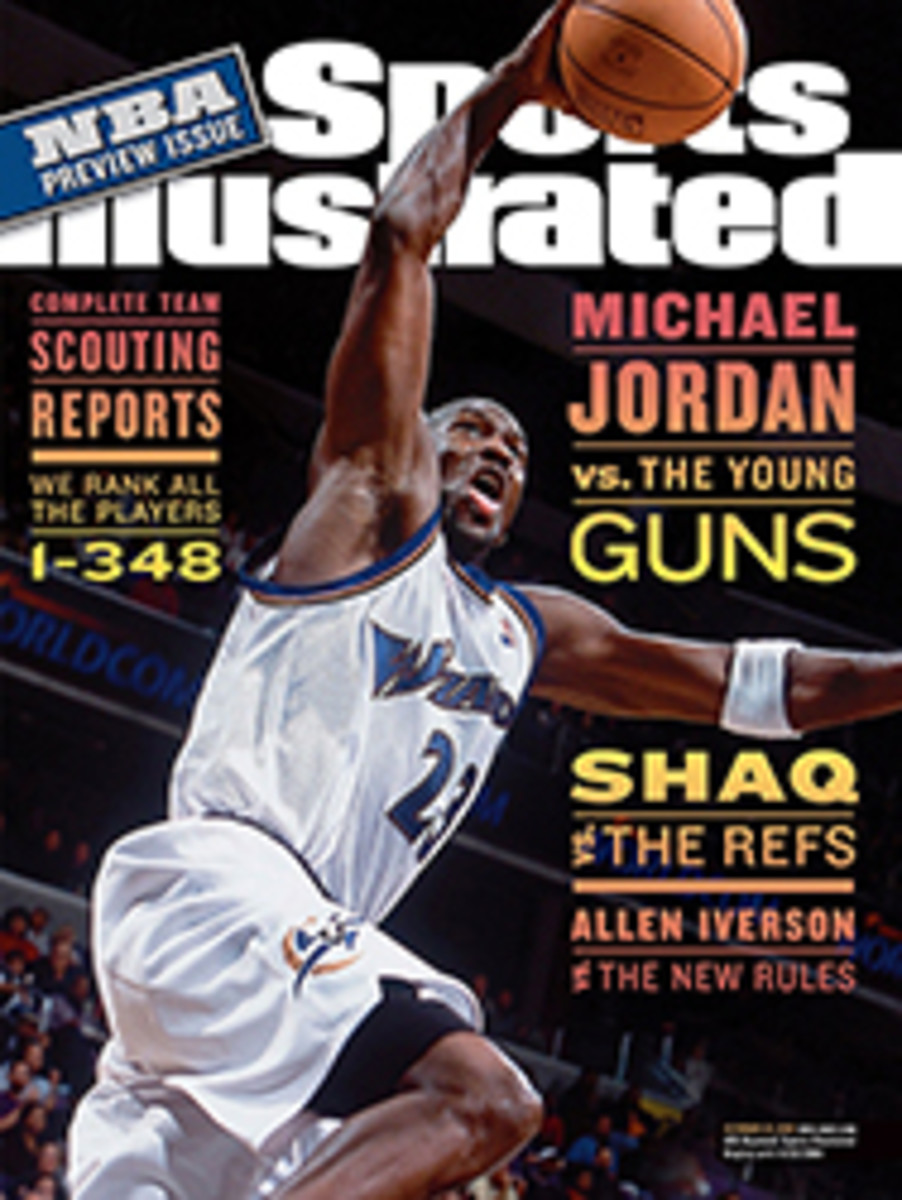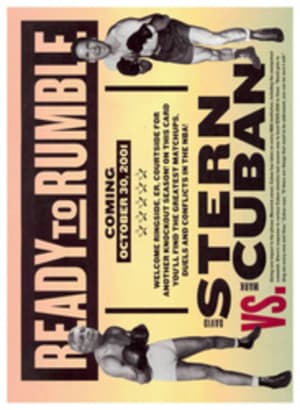
Iverson vs. The New Zone THE NEW RULES, WHICH ALLOW MORE DOUBLE-TEAMING, MAY WELL SPELL DOUBLE TROUBLE FOR THE 76ERS' STAR
Given the coarse rap lyrics he's been known to compose, it might
seem that Allen Iverson would be the last person to complain
about offensive language. There is at least one word, however,
that Iverson, the Philadelphia 76ers' prolific point producer,
considers indisputably obscene. He heard it as he was walking
down a corridor in the Staples Center in June, and for a moment
it no longer mattered to him that the Sixers had upset the Los
Angeles Lakers in Game 1 of the NBA Finals. Someone suggested
that only one type of defense had any chance of containing him,
then made the mistake of uttering its name. Iverson turned at the
sound of the Z word, the fire in his eyes as bright as the
diamonds in his ears. "Zone," he said. "Man, why did you have to
go and bring that up? You trying to mess with my good mood? I
don't want to hear that word until next year."
Next year is here, and Iverson won't be able to avoid the word,
or the defense, any longer. From the moment the NBA's Board of
Governors announced last April that the illegal-defense rules
would be dropped beginning this season, the league's elite
scorers have been girding to face the kind of exotic defensive
strategies they haven't seen since they were big men on campus.
Teams will be able to use any defense they choose, the only
restriction being that a defender may not stand in the lane for
more than three seconds unless he is closely guarding another
player. "The NBA is for men, and a grown man doesn't need to play
zone," says Shaquille O'Neal. "Why do you think they call it
man-to-man? If you can't play it, you shouldn't be here."
It's possible that zone defenses won't be as instantly popular
around the league as tattoos and luxury boxes, which would be
welcome news to Iverson, O'Neal and other one-on-one threats like
Kobe Bryant, Vince Carter, Tim Duncan, Steve Francis and Tracy
McGrady. "We are not going to be a zone team," says Dallas
Mavericks coach Don Nelson, the kind of unorthodox strategist who
might be expected to take advantage of any new options. "Zones
make teams lazy. We like aggressive man-to-man." The San Antonio
Spurs, with 7-footers Tim Duncan and David Robinson to station on
either side of the lane, would seem to be another zone-prone
team, but coach Gregg Popovich says he did not spend "one single
second" devising such a defense during the off-season. "What we
will do," adds Popovich, "is use zones in special situations,
specifically, out-of-bounds plays and maybe with limited time on
the shot clock."
Still, the elite players are sure to see more creative defenses
thrown at them at least occasionally, and Iverson, the reigning
scoring champion, seems a particularly inviting target. His skill
at breaking down a defender off the dribble and the quick release
on his jump shot make him arguably the toughest perimeter player
in the league to handle one-on-one. Because Philadelphia doesn't
have another scoring threat who's nearly as dangerous as Iverson,
opponents will be likely to dare the other Sixers to beat them
from outside.
Of course, Iverson and the Sixers have seen de facto zones
before. Under the old rules opponents often sent a second
defender to double-team him as soon as he received the ball in
the frontcourt, and the other three defenders would rotate to
cover Iverson's four teammates in what was essentially a matchup
zone (diagram below). To make sure the Sixer left open was the
one who would be the most difficult to pass to, the second
defender on Iverson usually came from the weak side. By the time
that player arrived, though, Iverson had frequently made his move
to the basket or released his jumper. In fact, having a player
rushing at him often worked to Iverson's advantage, because a
head fake or crossover dribble was all he needed to flash to the
hoop before the defender could change direction.
Now defenses won't have to do as much running and rotating. They
can station a defender, most likely their power forward or
center--perhaps both--on whichever side the 6-foot Iverson sets up.
The defense essentially gives him two options: try to beat two or
three defenders, or pass the ball. "Now he won't have the alleys
to split you," says Seattle SuperSonics assistant Dwane Casey.
"The big man can be stationary and be there waiting for him."
Against man-to-man defenses, the Sixers like to set up a series
of screens for Iverson, a gantlet his defender must negotiate to
keep up with him (diagram, page 108). Against a basic zone, those
screens aren't nearly as effective, because no individual
defender has to fight his way through them all. Responsibility
for Iverson will simply pass from one defender to another as he
moves around the court. Even the best zone has seams, however,
and the danger for any coach who deploys it is that a scorer as
quick and clever as Iverson will find those openings. "Zones may
work for a possession or two," says Mavericks assistant coach
Sidney Moncrief, "but the more they see them, the more great
players will exploit them by finding the holes."
When he can't find those cracks, Iverson will have to rely on his
outside shot, which he tried particularly hard to improve during
the off-season, at least until he had surgery on his right elbow
in September. (He's expected to be healthy by the start of the
season.) Although zones often leave a spot-up shooter unguarded,
that player will rarely be Iverson. With defenses focused on him,
he's more likely to be the one to dish to that open shooter.
"He'll have to burn people sometimes with his passes to keep them
honest," says Casey.
In a sense the other Sixers may find themselves facing zones more
than Iverson does. Philadelphia coach Larry Brown expects to see
the occasional combination defense in which a team tracks Iverson
with multiple defenders and plays zone against his teammates.
Being double-teamed is nothing new for Iverson or any other top
scorer in the league. The difference is that under the old rules,
a player couldn't be double-teamed until he had the ball. Now,
defenders can gang up on Iverson whenever and wherever they wish,
making it much tougher for him to get his hands on the ball.
"Teams can do that, but if the Sixers have any shooters at all,
one of the other guys will kill you," Casey says. "What teams
will do is shade him with two guys. The days of Iverson's getting
40 or 50--he'll have to expend a lot more energy to do that."
In other words, Philadelphia's success against the zone will
depend in part on how unselfish Iverson is willing to be. Beating
a double team and then penetrating against a three-man front
that's sagging to protect the middle will be far more difficult
than distributing the ball to an open teammate. "I won't have any
trouble giving the ball up," he says. "If I need to be a decoy
sometimes, then I'll be a decoy. My teammates can make shots."
In an attempt to make sure that's true, the Sixers acquired 6'7"
forward Matt Harpring, along with forwards Robert (Tractor)
Traylor and Cedric Henderson, from the Cavaliers during the
off-season for forwards Tyrone Hill and Jumaine Jones.
Philadelphia essentially replaced Hill, a solid rebounder and
defender, with the offensive-minded Harpring, who is more likely
to make defenses, zone or not, pay for being preoccupied with
Iverson.
On the other hand Brown hasn't made drastic strategic changes to
prepare Iverson to face zones. He is still preaching ball
movement and player movement, and encouraging Iverson to trust
his teammates to make the open shots that will inevitably come.
Since Brown and Iverson rarely agree on anything (at least
initially), it's no surprise that the coach is far more sanguine
about the changes than his star. "I don't see it as a problem,"
says Brown. "It will help the fans because nobody in the stands
really understood the illegal-defense rules anyway, and it will
make it easier on the referees because they won't have so much to
look for."
Another factor that could work to the Sixers' advantage is that
defenders in a zone often don't rebound well, because they aren't
always in position to box out their opponents when the shot goes
up. With hardworking interior players like center Dikembe Mutombo
and forward George Lynch, Philadelphia--a strong offensive
rebounding team that often cashes in on Iverson's misses--could
wind up with more than its share of second and third shots if
teams play zone for long stretches.
"Triple-team Allen if you want," Brown says. "You'll have to give
something up if you do that. Everything's a calculated risk. Do
it and you'll open up more opportunities for other people, which
in turn will make Allen more dangerous."
How Iverson fares against the new schemes designed to stop him
will be as clear an indicator as any of whether the rules changes
are having their desired effect. If teams playing zone repeatedly
cut off his forays to the basket and turn him into little more
than a passer and jump shooter, the rules committee that
recommended the changes may reassess them at season's end. If,
however, the specter of having to face a zone encourages teams to
push the ball up the floor before defenses can set up, creating
more of an open-court game, even Iverson and most of his fellow
stars will be pleased.
Iverson hopes that the pace of the game will be even more to his
liking, but he doesn't really expect it to happen. "I think it's
going to take a lot of creativity from the game," he says. "I'm
going to get into the lane, and four, five guys are going to be
sitting there waiting for me. The game will turn into a bunch of
guys shooting jump shots. You can't tell me that's what the fans
want to see."
Still, the game could turn into something more fascinating than
that. If the endlessly inventive Iverson has to find new ways to
attack the kitchen-sink defenses that will be thrown at him, it
will be well worth watching. The fans--and Iverson--may find that
the sturdier the shackles, the more impressive the escape.
COLOR PHOTO: PHOTOGRAPH BY MANNY MILLAN FORCED ENTRY With defenders able to collapse into the lane and block his path, Iverson will have to work even harder for his points.
COLOR PHOTO: JOHN BIEVER NO PASSING ZONE Under the old rules, Iverson couldn't be double-teamed until he had the ball, and the second defender (Lynch's man) often had to come crosscourt. Now teams don't have to wait, making it harder for the Sixers to get the ball into their star's hands.
COLOR DIAGRAM: ILLUSTRATIONS BY JOE ZEFF [See caption above] THEN
COLOR DIAGRAM: ILLUSTRATIONS BY JOE ZEFF [See caption above] NOW
COLOR PHOTO: JOHN BIEVER SCREEN SAVER Against man-to-man, Iverson, without the ball, can lose his defender by cutting around baseline screens. Under the new zone rules, each defender can guard Iverson in a particular area, then let a teammate pick him up as Iverson enters another zone.
COLOR DIAGRAM: ILLUSTRATIONS BY JOE ZEFF [See caption above] THEN
COLOR DIAGRAM: ILLUSTRATIONS BY JOE ZEFF [See caption above] NOW

